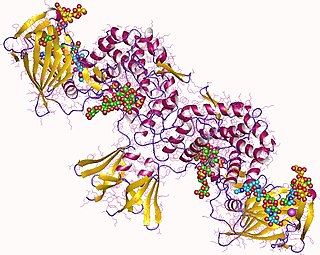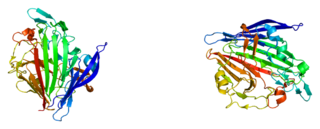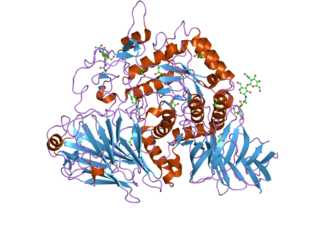
A disaccharide is the sugar formed when two monosaccharides are joined by glycosidic linkage. Like monosaccharides, disaccharides are simple sugars soluble in water. Three common examples are sucrose, lactose, and maltose.

Maltose, also known as maltobiose or malt sugar, is a disaccharide formed from two units of glucose joined with an α(1→4) bond. In the isomer isomaltose, the two glucose molecules are joined with an α(1→6) bond. Maltose is the two-unit member of the amylose homologous series, the key structural motif of starch. When beta-amylase breaks down starch, it removes two glucose units at a time, producing maltose. An example of this reaction is found in germinating seeds, which is why it was named after malt. Unlike sucrose, it is a reducing sugar.

Maltase is one type of alpha-glucosidase enzymes located in the brush border of the small intestine. This enzyme catalyzes the hydrolysis of disaccharide maltose into two simple sugars of glucose. Maltase is found in plants, bacteria, yeast, humans, and other vertebrates. It is thought to be synthesized by cells of the mucous membrane lining the intestinal wall.

Brown rice (malt) syrup, also known as rice syrup or rice malt, is a sweetener which is rich in compounds categorized as sugars and is derived by steeping cooked rice starch with saccharifying enzymes to break down the starches, followed by straining off the liquid and reducing it by evaporative heating until the desired consistency is reached. The enzymes used in the saccharification step are supplied by an addition of sprouted barley grains to the rice starch or by adding bacterial- or fungal-derived purified enzyme isolates.

β-Amylase is an enzyme with the systematic name 4-α-D-glucan maltohydrolase. It catalyses the following reaction:

Phosphopentose epimerase encoded by the RPE gene is a metalloprotein that catalyzes the interconversion between D-ribulose 5-phosphate and D-xylulose 5-phosphate.

Heparosan-N-sulfate-glucuronate 5-epimerase is an enzyme with systematic name poly( -beta-D-glucuronosyl- -N-sulfo-alpha-D-glucosaminyl) glucurono-5-epimerase. This enzyme catalyses the following chemical reaction

Galactose mutarotase is a human enzyme that converts alpha-aldose to the beta-anomer. This enzyme catalyzes the first step of the Leloir Pathway, which is involved in galactose metabolism. It belongs to family of aldose epimerases.
In enzymology, a 2-aminohexano-6-lactam racemase is an enzyme that catalyzes the chemical reaction
In enzymology, a 3-hydroxybutyryl-CoA epimerase is an enzyme that catalyzes the chemical reaction

In enzymology, an alanine racemase is an enzyme that catalyzes the chemical reaction
In enzymology, an aldose 1-epimerase is an enzyme that catalyzes the chemical reaction
In enzymology, a glucose-6-phosphate 1-epimerase is an enzyme that catalyzes the chemical reaction
In enzymology, a maltose α-D-glucosyltransferase is an enzyme that catalyzes the chemical reaction

In enzymology, a maltose phosphorylase is an enzyme that catalyzes the chemical reaction

Hydroxysteroid 17-beta dehydrogenase 6 is an enzyme that in humans is encoded by the HSD17B6 gene.

Maltase-glucoamylase, intestinal is an enzyme that in humans is encoded by the MGAM gene.

In molecular biology, Glycoside hydrolase family 14 is a family of glycoside hydrolases.

Neopullulanase is an enzyme of the alpha-amylase family with systematic name pullulan 4-D-glucanohydrolase (panose-forming). This enzyme principally catalyses the following chemical reaction by cleaving pullulan's alpha-1,4-glucosidic bonds:
N-acetylneuraminate epimerase is an enzyme with systematic name N-acetyl-alpha-neuraminate 2-epimerase. This enzyme catalyses the following chemical reaction














